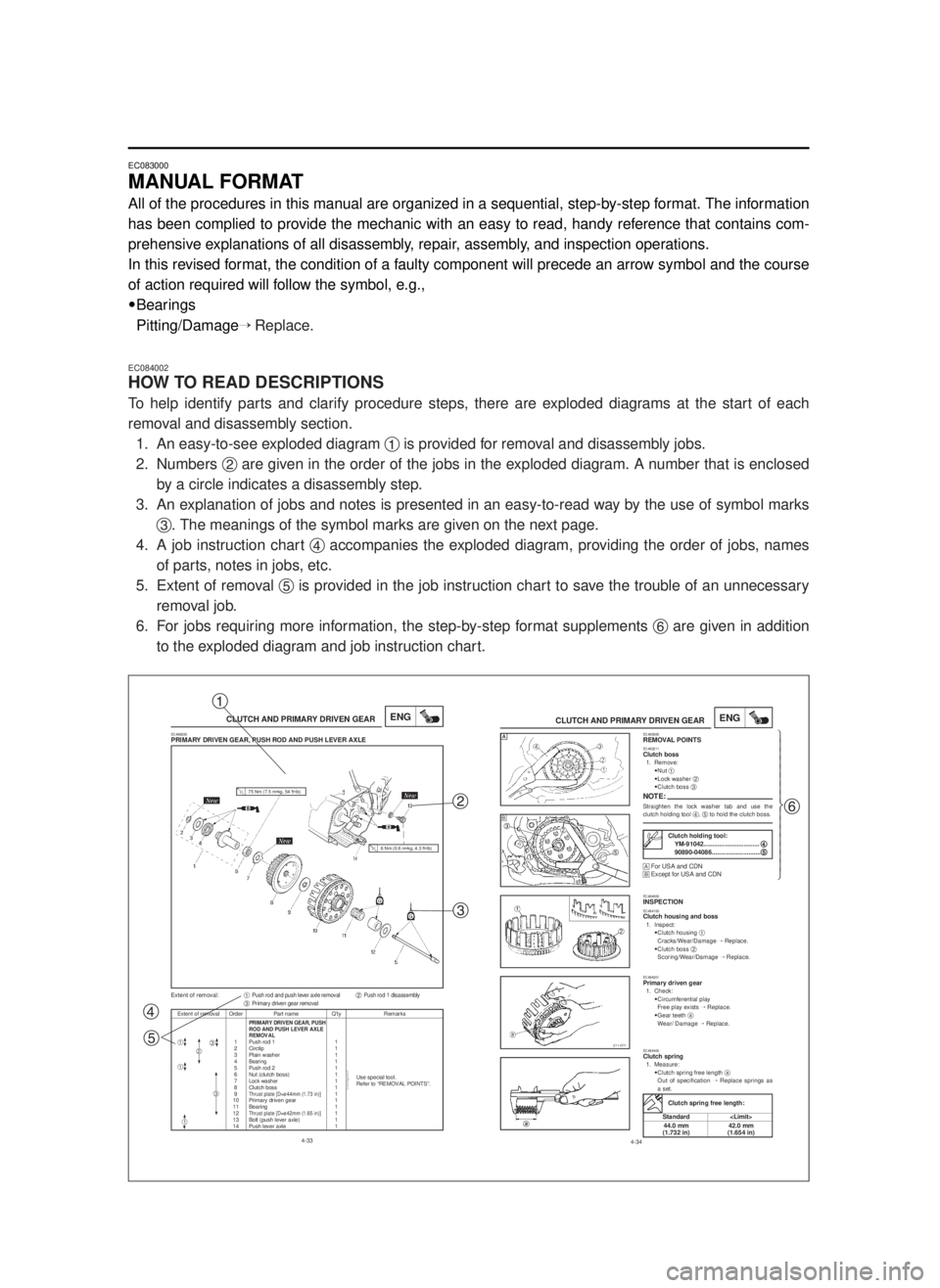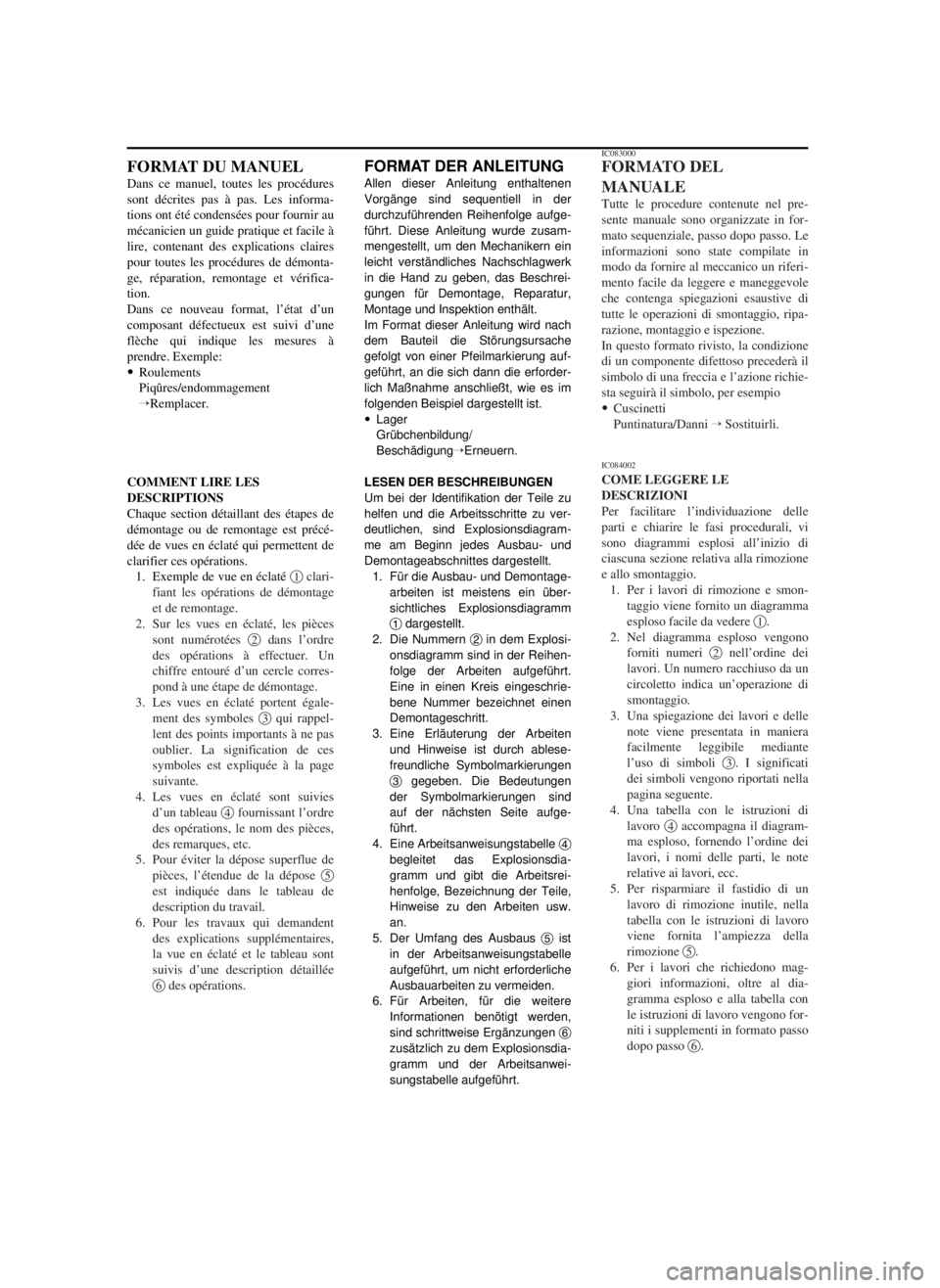2001 YAMAHA YZ250LC diagram
[x] Cancel search: diagramPage 14 of 578

EC083000
MANUAL FORMAT
All of the procedures in this manual are organized in a sequential, step-by-step format. The information
has been complied to provide the mechanic with an easy to read, handy reference that contains com-
prehensive explanations of all disassembly, repair, assembly, and inspection operations.
In this revised format, the condition of a faulty component will precede an arrow symbol and the course
of action required will follow the symbol, e.g.,
9Bearings
Pitting/DamageÕReplace.
EC084002
HOW TO READ DESCRIPTIONS
To help identify parts and clarify procedure steps, there are exploded diagrams at the start of each
removal and disassembly section.
1. An easy-to-see exploded diagram 1is provided for removal and disassembly jobs.
2. Numbers 2are given in the order of the jobs in the exploded diagram. A number that is enclosed
by a circle indicates a disassembly step.
3. An explanation of jobs and notes is presented in an easy-to-read way by the use of symbol marks
3. The meanings of the symbol marks are given on the next page.
4. A job instruction chart 4accompanies the exploded diagram, providing the order of jobs, names
of parts, notes in jobs, etc.
5. Extent of removal 5is provided in the job instruction chart to save the trouble of an unnecessary
removal job.
6. For jobs requiring more information, the step-by-step format supplements 6are given in addition
to the exploded diagram and job instruction chart.
4-33
CLUTCH AND PRIMARY DRIVEN GEARENG
Extent of removal Order Part name Q’ty RemarksPRIMARY DRIVEN GEAR, PUSHROD AND PUSH LEVER AXLE
REMOVAL1 Push rod 1 1
2 Circlip 1
3 Plain washer 1
4
Bearing 15 Push rod 2 1
6 Nut (clutch boss) 1
Use special tool.
7Lock washer1
Refer to “REMOVAL POINTS”.
8 Clutch boss 1
9Thrust plate [D=ø44mm (1.73 in)]1
10 Primary driven gear 1
11 Bearing 1
12
Thrust plate [D=ø42mm (1.65 in)]1
13 Bolt (push lever axle) 1
14 Push lever axle 1
EC498200PRIMARY DRIVEN GEAR, PUSH ROD AND PUSH LEVER AXLE
Extent of removal:1Push rod and push lever axle removal2Push rod 1 disassembly3Primary driven gear removal
23
1
1
1
ü
ï
ý
ï
þ
3
75 Nm (7.5 m•kg, 54 ft•lb)
6 Nm (0.6 m•kg, 4.3 ft•lb)
4-34
CLUTCH AND PRIMARY DRIVEN GEARENGEC493000REMOVAL POINTSEC483211Clutch boss1. Remove:
9Nut 1
9Lock washer 2
9Clutch boss 3
NOTE:Straighten the lock washer tab and use the
clutch holding tool 4, 5to hold the clutch boss.
ŒFor USA and CDN
ºExcept for USA and CDN
EC494000INSPECTIONEC484100Clutch housing and boss1. Inspect:
9Clutch housing 1
Cracks/Wear/Damage Õ Replace.
9Clutch boss 2
Scoring/Wear/Damage ÕReplace.
EC484201Primary driven gear1. Check:
9Circumferential play
Free play exists ÕReplace.
9Gear teeth a
Wear/ Damage ÕReplace.
EC484400Clutch spring1. Measure:
9Clutch spring free length a
Out of specification ÕReplace springs as
a set.
Clutch holding tool:
YM-91042................................4 4
90890-04086............................5 5
Clutch spring free length:
Standard
44.0 mm 42.0 mm
(1.732 in) (1.654 in)
Œ
ºŒü
ï
ï
ï
ï
ï
ï
ï
ý
ï
ï
ï
ï
ï
ï
ï
þ
1
2
3
4
56
5MW-9-30-0 7/5/00 2:14 PM Page 12
Page 15 of 578

FORMAT DER ANLEITUNG
Allen dieser Anleitung enthaltenen
Vorgänge sind sequentiell in der
durchzuführenden Reihenfolge aufge-
führt. Diese Anleitung wurde zusam-
mengestellt, um den Mechanikern ein
leicht verständliches Nachschlagwerk
in die Hand zu geben, das Beschrei-
gungen für Demontage, Reparatur,
Montage und Inspektion enthält.
Im Format dieser Anleitung wird nach
dem Bauteil die Störungsursache
gefolgt von einer Pfeilmarkierung auf-
geführt, an die sich dann die erforder-
lich Maßnahme anschließt, wie es im
folgenden Beispiel dargestellt ist.
9Lager
Grübchenbildung/
Beschädigung
ÕErneuern.
LESEN DER BESCHREIBUNGEN
Um bei der Identifikation der Teile zu
helfen und die Arbeitsschritte zu ver-
deutlichen, sind Explosionsdiagram-
me am Beginn jedes Ausbau- und
Demontageabschnittes dargestellt.
1. Für die Ausbau- und Demontage-
arbeiten ist meistens ein über-
sichtliches Explosionsdiagramm
1dargestellt.
2. Die Nummern 2in dem Explosi-
onsdiagramm sind in der Reihen-
folge der Arbeiten aufgeführt.
Eine in einen Kreis eingeschrie-
bene Nummer bezeichnet einen
Demontageschritt.
3. Eine Erläuterung der Arbeiten
und Hinweise ist durch ablese-
freundliche Symbolmarkierungen
3gegeben. Die Bedeutungen
der Symbolmarkierungen sind
auf der nächsten Seite aufge-
führt.
4. Eine Arbeitsanweisungstabelle 4
begleitet das Explosionsdia-
gramm und gibt die Arbeitsrei-
henfolge, Bezeichnung der Teile,
Hinweise zu den Arbeiten usw.
an.
5. Der Umfang des Ausbaus 5ist
in der Arbeitsanweisungstabelle
aufgeführt, um nicht erforderliche
Ausbauarbeiten zu vermeiden.
6. Für Arbeiten, für die weitere
Informationen benötigt werden,
sind schrittweise Ergänzungen 6
zusätzlich zu dem Explosionsdia-
gramm und der Arbeitsanwei-
sungstabelle aufgeführt.
FORMAT DU MANUEL
Dans ce manuel, toutes les procédures
sont décrites pas à pas. Les informa-
tions ont été condensées pour fournir au
mécanicien un guide pratique et facile à
lire, contenant des explications claires
pour toutes les procédures de démonta-
ge, réparation, remontage et vérifica-
tion.
Dans ce nouveau format, l’état d’un
composant défectueux est suivi d’une
flèche qui indique les mesures à
prendre. Exemple:
9Roulements
Piqûres/endommagement
ÕRemplacer.
COMMENT LIRE LES
DESCRIPTIONS
Chaque section détaillant des étapes de
démontage ou de remontage est précé-
dée de vues en éclaté qui permettent de
clarifier ces opérations.
1. Exemple de vue en éclaté 1clari-
fiant les opérations de démontage
et de remontage.
2. Sur les vues en éclaté, les pièces
sont numérotées 2dans l’ordre
des opérations à effectuer. Un
chiffre entouré d’un cercle corres-
pond à une étape de démontage.
3. Les vues en éclaté portent égale-
ment des symboles 3qui rappel-
lent des points importants à ne pas
oublier. La signification de ces
symboles est expliquée à la page
suivante.
4. Les vues en éclaté sont suivies
d’un tableau 4fournissant l’ordre
des opérations, le nom des pièces,
des remarques, etc.
5. Pour éviter la dépose superflue de
pièces, l’étendue de la dépose 5
est indiquée dans le tableau de
description du travail.
6. Pour les travaux qui demandent
des explications supplémentaires,
la vue en éclaté et le tableau sont
suivis d’une description détaillée
6des opérations.
IC083000
FORMATO DEL
MANUALE
Tutte le procedure contenute nel pre-
sente manuale sono organizzate in for-
mato sequenziale, passo dopo passo. Le
informazioni sono state compilate in
modo da fornire al meccanico un riferi-
mento facile da leggere e maneggevole
che contenga spiegazioni esaustive di
tutte le operazioni di smontaggio, ripa-
razione, montaggio e ispezione.
In questo formato rivisto, la condizione
di un componente difettoso precederà il
simbolo di una freccia e l’azione richie-
sta seguirà il simbolo, per esempio
9Cuscinetti
Puntinatura/Danni ÕSostituirli.
IC084002
COME LEGGERE LE
DESCRIZIONI
Per facilitare l’individuazione delle
parti e chiarire le fasi procedurali, vi
sono diagrammi esplosi all’inizio di
ciascuna sezione relativa alla rimozione
e allo smontaggio.
1. Per i lavori di rimozione e smon-
taggio viene fornito un diagramma
esploso facile da vedere 1.
2. Nel diagramma esploso vengono
forniti numeri 2nell’ordine dei
lavori. Un numero racchiuso da un
circoletto indica un’operazione di
smontaggio.
3. Una spiegazione dei lavori e delle
note viene presentata in maniera
facilmente leggibile mediante
l’uso di simboli 3. I significati
dei simboli vengono riportati nella
pagina seguente.
4. Una tabella con le istruzioni di
lavoro 4accompagna il diagram-
ma esploso, fornendo l’ordine dei
lavori, i nomi delle parti, le note
relative ai lavori, ecc.
5. Per risparmiare il fastidio di un
lavoro di rimozione inutile, nella
tabella con le istruzioni di lavoro
viene fornita l’ampiezza della
rimozione 5.
6. Per i lavori che richiedono mag-
giori informazioni, oltre al dia-
gramma esploso e alla tabella con
le istruzioni di lavoro vengono for-
niti i supplementi in formato passo
dopo passo 6.
5MW-9-30-0 7/5/00 2:14 PM Page 13
Page 17 of 578

ABGEBILDETEN SYMBOLE
(Siehe Abbildung)
Die abgebildeten Symbole 1bis 7
sind zur einfachen Auffindung der Sei-
ten mit Daumeneinkerbungen verse-
hen. Die Abschnittsnummer sowie der
lnhalt können sofort ersehen werden.
1Allgemein Angaben
2Technische Daten
3Regelmäßige Prüfung und
Einstellungen
4Motor
5Fahrgestell
6Elektrische Einrichtungen
7Tuning
Die abgebildeten Symbole von 8bis
rwerden zur Unterscheidung der
Spezifikationen in diesem Text
benutzt.
8Mit dem Motor eingebaut
9Spezialwerkzeug
0Einfüllen von Flüssigkeit
qSchmiermittel
wFestziehen (Anzugsmoment)
eVerschleißgrenze, Wartungs-
Toleranzgrenze
rWiderstand (½), Spannung (V),
elektrischer Strom (A)
Die abgebildeten Symbole tbis oin
der Explosionszeichnung zeigen die
Schmierstoffklasse sowie die
Schmierstellen an.
tGetriebeöl auftragen
yMotor-Mischöl auftragen
uMolybdändisulfid-Öl auftragen
iLeichtes Lithium-Fett auftragen
oMolybdändisulfid-Fett auftragen
Die abgebildeten Symbole pbis ain
der Explosionszeichnung zeigen die
Stellen, wo Sicherungslack aufzutra-
gen ist und neue Teile einzubauen
sind.
pSicherungslack (LOCTITE®)
auftragen
aNeues Teil verwenden
SYMBOLES GRAPHIQUES
(Voir l’illustration)
Les symboles graphiques 1à 7ser-
vent à repérer les différents chapitres et
à indiquer leur contenu.
1Renseignements généraux
2Caracteristiques
3Verification et réglages courants
4Moteur
5Partie cycle
6Partie électrique
7Mise au point
Les symboles graphiques 8á rper-
mettent d’identifier les spécifications
encadrées dans le texte.
8Avec de montage du moteur
9Outil spécial
0Liquide de remplissage
qLubrifiant
wSerrage
eValeur spécifiée, limite de service
rRésistance (½), tension (V), intensité (A)
Les symboles graphiques tà odans
les vues éclatées indiquent le grade de
lubrifiant et l’emplacement des points
de lubrification.
tAppliquer de l’huile de transmissionyAppliquer de l’huile de mélange du moteuruAppliquer de l’huile au bisulfure de molybdèneiAppliquer de la graisse fluide à base de savon
au lithium
oAppliquer de la graisse au bisulfure de
molybdène
Les symboles graphiques pet adans
les vues éclatées indiquent où appliquer
de l’agent bloquant et où installer de
nouveaux composants.
pAppliquer un agent de blocage
(LOCTITE®)
aUtiliser une pièce neuve
IC085002
SIMBOLI ILLUSTRATI
(Fare riferimento all’illustra-
zione)
I simboli illustrati da 1a 7sono pro-
gettati come linguette da sfogliare che
indichino il numero e il contenuto del
capitolo.
1Informazioni generali
2Specifiche
3Ispezione e regolazioni regolari
4Motore
5Telaio
6Parte elettrica
7Messa a punto
I simboli illustrati da 8a rvengono
usati per identificare le specifiche che
compaiono nel testo.
8Con motore montato
9Utensile speciale
0Liquido di riempimento
qLubrificante
wSerraggio
eValore specificato, limite di servizio
rResistenza (½), Tensione (V), Corrente
elettrica (A)
I simboli da ta oillustrati nei dia-
grammi esplosi indicano la qualità di
lubrificante e la posizione del punto di
lubrificazione.
tApplicare olio per trasmissioneyApplicare olio per miscela per motoriuApplicare olio a base di bisolfuro di molibdenoiApplicare grasso leggero a base di sapone di
litio
oApplicare grasso a base di bisolfuro di
molibdeno
I simboli pe aillustrati nei diagram-
mi esplosi indicano dove applicare
l’agente bloccante e dove montare il
pezzo di ricambio.
pApplicare agente bloccante
(LOCTITE®)
aUsare un pezzo nuovo
5MW-9-30-0 7/5/00 2:15 PM Page 15
Page 20 of 578

EC0A0000
CONTENTS
CHAPTER 1
GENERAL INFORMATION
DESCRIPTION............................................1-1
MACHINE IDENTIFICATION......................1-2
IMPORTANT INFORMATION.....................1-3
CHECKING OF CONNECTION..................1-6
SPECIAL TOOLS........................................1-7
CONTROL FUNCTIONS.............................1-9
FUEL AND ENGINE MIXING OIL.............1-12
STARTING AND BREAK-IN.....................1-13
TORQUE-CHECK POINTS.......................1-16
CLEANING AND STORAGE....................1-17
CHAPTER 2
SPECIFICATIONS
GENERAL SPECIFICATIONS....................2-1
MAINTENANCE SPECIFICATIONS...........2-3
GENERAL TORQUE SPECIFICATIONS..2-12
DEFINITION OF UNITS............................2-12
CABLE ROUTING DIAGRAM...................2-13
CHAPTER 3
REGULAR INSPECTION
AND ADJUSTMENTS
MAINTENANCE INTERVALS.....................3-1
PRE-OPERATION INSPECTION AND
MAINTENANCE..........................................3-4
ENGINE.......................................................3-5
CHASSIS...................................................3-17
ELECTRICAL............................................3-38
5MW-9-30-0 7/5/00 2:15 PM Page 18
Page 21 of 578

TABLES DES
MATIERES
CHAPITRE 1
RENSEIGNEMENTS
GENERAUX
DESCRIPTION...........................................1-1
IDENTIFICATION DE LA MACHINE...1-2
INFORMATIONS IMPORTANTES........1-3
VERIFICATION DES CONNEXIONS....1-6
OUTILS SPECIAUX...................................1-7
FONCTIONS DES COMMANDES...........1-9
ESSENCE ET HUILE DE MELANGE
DU MOTEUR............................................1-12
MISE EN MARCHE ET RODAGE........1-13
POINTS DE VERIFICATION DE
COUPLE DE SERRAGE..........................1-16
NETTOYAGE ET RANGEMENT..........1-17
CHAPITRE 2
CARACTERISTIQUES
CARACTERISTIQUES GENERALES....2-1
CARACTERISTIQUES D'ENTRETIEN.2-3
SPECIFICATIONS GENERALES
DE COUPLE..............................................2-12
DEFINITION DES UNITES....................2-12
SCHEMA DE CHEMINEMENT DES
CABLES.....................................................2-13
CHAPITRE 3
VERIFICATION ET
REGLAGES COURANTS
PROGRAMME D’ENTRETIEN...............3-1
INSPECTION ET ENTRETIEN
AVANT UTILISATION.............................3-4
MOTEUR.....................................................3-5
PARTIE CYCLE.......................................3-17
PARTIE ELECTRIQUE..........................3-38
INHALTSVERZEICHNIS
KAPITEL 1
ALLGEMEIN
ANGABEN
BESCHREIBUNG.......................................1-1
MASCHINEN-IDENTIFIKATION.................1-2
WICHTIGE INFORMATIONEN...................1-3
ANSCHLÜSSE PRÜFEN............................1-6
SPEZIALWERKZEUGE..............................1-7
BEDIENUNGSELEMENTE.........................1-9
KRAFTSTOFF UND
MOTORGEMISCHÖL...............................1-12
STARTEN UND EINFAHREN...................1-13
ANZUGSMOMENTE-PRÜFPUNKTE.......1-16
REINIGEN UND LAGERUNG...................1-17
KAPITEL 2
TECHNISCHE DATEN
ALLGEMEINE TECHNISCHE DATEN.......2-1
WARTUNGSDATEN...................................2-3
ALLGEMEINE ANZUGSDATEN..............2-12
DEFINITION DER EINHEITEN.................2-12
KABELFÜHRUNGSÜBERSICHTPLAN...2-13
KAPITEL 3
REGELMÄSSIGE PRÜ-
FUNG
UND EINSTELLUNGEN
WARTUNGSINTERVALLE.........................3-1
PRÜFUNG UND WARTUNG VOR
DER INBETRIEBNAHME...........................3-4
MOTOR.......................................................3-5
FAHRGESTELL........................................3-17
ELEKTRISCHE EINRICHTUNGEN..........3-38
IC0A0000
INDICE
CAPITOLO 1
INFORMAZIONI
GENERALI
DESCRIZIONE...........................................1-1
IDENTIFICAZIONE DEL VEICOLO.....1-2
INFORMAZIONI IMPORTANTI.............1-3
CONTROLLO DEI COLLEGAMENTI...1-6
UTENSILI SPECIALI................................1-7
FUNZIONI DEI COMANDI......................1-9
CARBURANTE E OLIO PER MISCELA
PER MOTORI...........................................1-12
AVVIO E RODAGGIO.............................1-13
PUNTI DI CONTROLLO DELLA
COPPIA......................................................1-16
PULITURA E IMMAGAZZINAMENTO..1-17
CAPITOLO 2
SPECIFICHE
SPECIFICHE GENERALI........................2-1
SPECIFICHE DI MANUTENZIONE.......2-3
SPECIFICHE GENERALI RELATIVE
ALLA COPPIA..........................................2-12
DEFINIZIONE DELLE UNITÀ..............2-12
DIAGRAMMA DEL PASSAGGIO
DEI CAVI...................................................2-13
CAPITOLO 3
REVISIONE E
REGOLAZIONI
REGOLARI
INTERVALLI DI MANUTENZIONE......3-1
ISPEZIONE E MANUTENZIONE PRIMA
DEL FUNZIONAMENTO..........................3-4
MOTORE.....................................................3-5
TELAIO......................................................3-17
PARTE ELETTRICA...............................3-38
5MW-9-30-0 7/5/00 2:15 PM Page 19
Page 24 of 578

CHAPTER 6
ELECTRICAL
ELECTRICAL COMPONENTS AND
WIRING DIAGRAM.....................................6-1
IGNITION SYSTEM.....................................6-2
SOLENOID VALVE SYSTEM......................6-6
TPS (THROTTLE POSITION SENSOR)
SYSTEM......................................................6-8
CHAPTER 7
TUNING
ENGINE.......................................................7-1
CHASSIS...................................................7-13
5MW-9-30-0 7/5/00 2:15 PM Page 22
Page 116 of 578

2-13
CABLE ROUTING DIAGRAMSPEC
EC240000
CABLE ROUTING DIAGRAM
1Cable guide
2Clamp
3“ENGINE STOP” button lead
4Throttle cable
5TPS (throttle position sensor)
lead
6Solenoid valve lead
7CDI unit
8CDI unit stay
9CDI unit band
0Air vent hose (left)
qTransmission oil breather hose
wOverflow hose
eAir vent hose (right)APass the throttle cable and
“ENGINE STOP” button lead into
the cable guide. Align with the
cable guide the front end of the
tape on the throttle cable.
BClamp the throttle cable,
“ENGINE STOP” button lead and
CDI unit lead with the clamp
ends downward.
CPass the throttle cable, “ENGINE
STOP” button lead and CDI unit
lead over the radiator hose.
DClamp the clutch cable, throttle
cable, “ENGINE STOP” button
lead, TPS (throttle position sen-
sor) lead and solenoid valve lead
with the clamp ends downward.
In so doing, clamp the “ENGINE
STOP” button lead at its protect-
ing tube.
EClamp the clutch cable so that
the clamp passes with its ends
downward, as shown.
FPass the TPS (throttle position
sensor) lead and solenoid valve
lead through the cable guide.GClamp the TPS (throttle position
sensor) lead and solenoid valve
lead to the frame with the clamp
ends backward.
HPass the solenoid valve lead
through the carburetor clamp.
IPass the air vent hoses, overflow
hose and transmission oil
breather hose between the frame
and connecting rod.
JFit the CDI unit into the CDI unit
stay till it stops.
KInsert the CDI unit into the CDI
unit band till it stops.
LPass the TPS (throttle position
sensor) lead and solenoid valve
lead under the damper.
MClamp the air vent hoses.
NPass the air vent hoses, overflow
hose and transmission oil
breather hose so that all these
hoses do not contact the rear
shock absorber.
5MW-9-30-2 7/3/00 2:24 PM Page 50
Page 117 of 578

2-13
SCHEMA DE CHEMINEMENT DES CABLES
KABELFÜHRUNGSÜBERSICHTPLAN
DIAGRAMMA DEL PASSAGGIO DEI CAVISPEC
KABELFÜHRUNGSÜBER-
SICHTPLAN
1Kabelführung
2Klemme
3
Leitungskabel des Motorstoppknopfes „ENGINE STOP”4Gasseil
5TPS-Leitungskabel (Drosselstellungssensor)6Magnetventilleitung
7CDI-Einheit
8Stütze der CDI-Einheit
9Band der CDI-Einheit
0Belüftungsschlauch (Links)
qGetriebeöl-Belüftungsschlauch
wÜberlaufschlauch
eBelüftungsschlauch (Rechts)
ADas Gasseil und den Leitungskabel des
Motorstoppknopfes „ENGINE STOP“
durch die Kabelführung führen. Vorde-
res Bandende am Gaskabel mit der
Kabelführung ausrichten.
BDrosselkabel festklemmen, Leitungska-
bel des Motorstoppknopfse „ENGINE
STOP“ und CDI-Einheitsleitung mit den
Klemmenden nach unten.
CDrosselkabel festklemmen, Leitungska-
bel des Motorstoppknopfes „ENGINE
STOP“ und CDI-Einheitsleitung über
dem Kühlerschlauch.
DKupplungskabel, Drosselkabel, Lei-
tungskabel des Motorstoppknopfes
“ENGINE STOP”, TPS-Leitungskabel
(Drosselstellungssensor) und Magnet-
ventilleitungskabel mit den Klemmenen-
den nach unten festklemmen. Dabei
wird das Leitungskabel des Motorstopp-
knopfes “ENGINE STOP” an seinem
Schutzrohr festgeklemmt.
E
Kupplungskabel so festklemmen, daß die
Klemme mit ihren Enden nach unten
durchgeführt wird, entsprechend der Abbil-
dung.
FTPS-Leitungskabel (Drosselstellungssen-
sor) und Magnetventilleitungskabel durch
die Kabelführung ziehen.
GTPS-Leitungskabel (Drosselstellungs-
sensor) und Magnetventilleitungskabel
mit den Klemmenden nach hinten am
Rahmen festklemmen.
H
Magnetventilleitung durch die Vergaser-
klemme führen.
IDie Belüftungsschläuche, den Überlauf-
schlauch und den Getriebeöl-Belüftungs-
schlauch zwischen dem Rahmen und der
Pleuelstange durchführen.
JDas Band der CDI-Einheit bis zum
Anschlag über die Stütze der CDI-Ein-
heit fühten.
K
CDI-Einheit bis zum Anschlag in die CDI-
Einheitsleiste einführen.
LTPS-Leitungskabel (Drosselstellungssen-
sor) und Magnetventilleitungskabel unter
dem Dämpfer durchführen.
MBelüftungsschläuche festklemmen.NDie Belüftungsschläuche, den Überlauf-
schlauch und den Getriebeöl-Belüftungs-
schlauch so durchführen, daß diese
Schläuche den Hinterrad-Stoßdämpfer
nicht berühren.
SCHEMA DE
CHEMINEMENT DES
CABLES
1Guide de câble
2Bride
3
Fil de bouton d’arrêt du moteur “ENGINE STOP”4Câble d’accélérateur
5Fil du TPS (capteur de position du papillon)6Fil d’électrovanne
7Bloc CDI
8Anorage du bloc CDI
9Bandeau du bloc CDI
0Tuyau de ventilation (gauche)
q
Tuyau de reniflard d’huile de boîte de vitesseswTuyau de trop-plein
eTuyau de ventilation (droit)
AFaire passer le câble d’accélérateur et le
fil du bouton d’arrêt du moteur “ENGI-
NE STOP” dans le guide de câble. Ali-
gner sur le guide-câble l’extrémité avant
du ruban du câble d’accélérateur.
BBridez le câble d’accélérateur, le fil du
bouton “ENGINE STOP” et le fil de
l’unité CDI en orientant les extrémités de
la bride vers le bas.
CFaites passer le câble d’accélérateur, le
fil du bouton “ENGINE STOP” et le fil
de l’unité CDI au-dessus de la durit de
radiateur.
DBridez le câble d’embrayage, le câble
d’accélérateur, le fil du bouton “ENGI-
NE STOP”, le fil du capteur de position
du papillon (TPS) et le fil de l’électro-
vanne en orientant les extrémités de la
bride vers le bas. Ce faisant, bridez le fil
du bouton “ENGINE STOP” sur sa gaine
de protection.
EBridez le câble d'embrayage de façon à
ce que la bride se présente avec les extré-
mités vers le bas comme illustré.
FFaites passer le fil du capteur de position
du papillon (TPS) et le fil de l’électro-
vanne dans le guide de câble.
GBridez le fil du capteur de position du
papilon (TPS) et le fil de l’électrovanne
au cadre en orientant les extrémités de la
bride vers l’arrière.
HFaites passer le fil de l’électrovanne dans
la bride du carburateur.
IFaire passer les tuyaux de ventilation, le
tuyau de trop-plein et le tuyau de renifi-
lard d’huile de transmission entre le
cadre et la bielle.
JAdapter complètement le bandeau du
bloc CDI sur l’ancrage du bloc CDI.
KIntroduisez à fond l’unité CDI dans le
collier de l’unité CDI.
LFaites passer le fil du capteur de position
du papillon (TPS) et le fil de l’électro-
vanne sous l’amortisseur.
MBridez les tuyaux de ventilation.
N
Faire passer les tuyaux de ventilation, le
tuyau de trop-plein et le tuyau de reniflard
d’huile de transmission de sorte qu’ils ne
touchent pas l’amortisseur arrière.
IC240000
DIAGRAMMA DEL
PASSAGGIO DEI CAVI
1Guida per cavi
2Brida
3
Conduttore del pulsante “ARRESTO MOTORE”4Cavo dell’acceleratore
5Conduttore TPS (sensore di posizione gas)6Conduttore elettrovalvola
7Unità CDI
8Supporto unità CDI
9Nastro dell’unità CDI
0Tubo flessibile dello sfiatatoio dell’aria
(sinistro)
qSfiato dell’olio per trasmissioni
wTubo flessibile di troppopieno
eTubo flessibile dello sfiatatoio dell’aria
(destro)
AFar passare il cavo dell’acceleratore e il
conduttore del pulsante “ARRESTO
MOTORE” nella guida per cavi. Allinea-
re con la guida per cavi l’estremità ante-
riore del nastro sul cavo dell’accelerato-
re.
BFermare il cavo del gas, il conduttore del
pulsante “ARRESTO MOTORE” e il con-
duttore dell’unità CDI con le estremità della
fascia rivolte verso il basso.
CFar scorrere il cavo del gas, il conduttore
del pulsante “ARRESTO MOTORE” e il
conduttore dell’unità CDI sopra il tubo del
radiatore.
DFermare il cavo della frizione, il cavo
dell’acceleratore, il conduttore del pulsante
di arresto motore, il sensore di posizione
gas TPS e il conduttore dell’elettrovalvola
con le estremità della fascia rivolte verso il
basso. Nell’effettuare questa operazione,
fissare il conduttore del pulsante “ARRE-
STO MOTORE” sul tubo di protezione.
EFissare il cavo della frizione in modo tale
che le estremità della fascetta siano rivolte
verso il basso, come illustrato.
FFar passare il conduttore TPS (sensore di
posizione gas) e l’elettrovalvola attraverso
la guida del cavo.
GFissare al telaio il conduttore TPS (sen-
sore di posizione dell’acceleratore) e
l’elettrovalvola con le estremità della
fascia all’indierto.
HFar scorrere il conduttore dell’elettrovalvola
attraverso la fascia del carburatore.
IFar passare i tubi di spurgo dell’aria, il tubo
di troppopieno e lo sfiato dell’olio di tra-
smissione tra il telaio e la biella.
JMontare la banda dell’unità CDI sul sup-
porto di quest’ultima fino a quando non
si arresta.
KInserire l’unità CDI nella fascia dell’unità
CDI fino a quando non si arresti.
LFar passare il conduttore TPS (sensore di
posizione gas) e il conduttore dell’elettro-
valvola sotto lo smorzatore di vibrazioni.
MFissare i tubi di sfiato.
NFar passare i tubi di sfiato dell’aria, il tubo
di troppopieno e lo sfiato dell’olio di tra-
smissione in modo che tutti questi tubi non
tocchino l’ammortizzatore posteriore.
5MW-9-30-2 7/3/00 2:24 PM Page 51